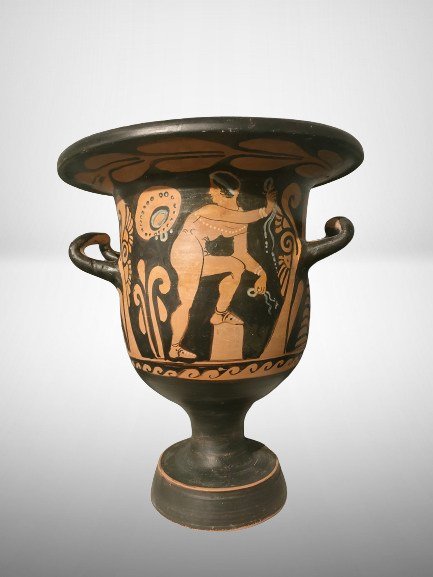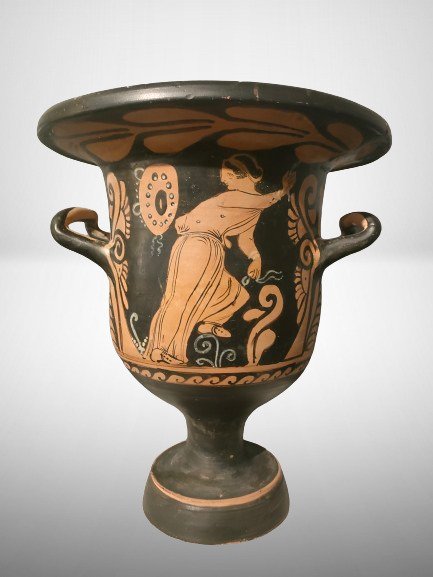In attesa nuovo lotto
Übersetzung ansehenAltgriechisch, Magna Graecia Apulisch Glockenkrater mit spanischer Exportlizenz
Nr. 88228789



Apulian red-figure bell krater. Greece. South Italian. ca. 370-325 B.C. Side A with a standing, naked young man, an athlete or maybe a satyr with the left leg elevated and supported on a pedestal. He appears holding garlands in his hands and wearing only a ribbon in his hair, bracelets and sandals and a dotted ribbon on his chest. He appears looking back. Behind him there is a plant and a tympanum. Side B with a drapped maenad in the same position with her left foot on a plant and looking back. Palmettes under handles. Band of wavy motifs under main field. Laurel wreath under rim.
The krater was made to be used at a symposion or by someone aspiring to host one. In ancient Greek society, it was crucial to mix wine with water, as drinking undiluted wine was seen as the actions of a drunkard. This is a "plain style" red-figure bell krater. The "plain style" refers to bell kraters that have no more than four figures. Although the earliest bell kraters were made for elites, after the middle of the fourth century, they became one of the earliest known crafts produced for the masses. These also drew inspiration from Attic pottery (perhaps by emigration by Athenian artists during the Peloponnesian War), but, because they were produced by Greek colonists in South Italy, have distinctly Italian elements.
Dimensions: 34,50 x 30,00 cm.
Condition: Restored over fracture lines from original fragments. Good condition.
Provenance:
- Spanish antiquarian.
- C.R. Private Collection since 2023 ( France )
- P.L private collection since 1985 ( France )
Notes:
A Certificate of Authenticity will accompany this lot. The piece includes spanish export license for the European Union. If the piece goes outside the European Union a new export license will be requested. This process can take between 2 and 4 week.s
#MasterpiecesW39
Apulian red-figure bell krater. Greece. South Italian. ca. 370-325 B.C. Side A with a standing, naked young man, an athlete or maybe a satyr with the left leg elevated and supported on a pedestal. He appears holding garlands in his hands and wearing only a ribbon in his hair, bracelets and sandals and a dotted ribbon on his chest. He appears looking back. Behind him there is a plant and a tympanum. Side B with a drapped maenad in the same position with her left foot on a plant and looking back. Palmettes under handles. Band of wavy motifs under main field. Laurel wreath under rim.
The krater was made to be used at a symposion or by someone aspiring to host one. In ancient Greek society, it was crucial to mix wine with water, as drinking undiluted wine was seen as the actions of a drunkard. This is a "plain style" red-figure bell krater. The "plain style" refers to bell kraters that have no more than four figures. Although the earliest bell kraters were made for elites, after the middle of the fourth century, they became one of the earliest known crafts produced for the masses. These also drew inspiration from Attic pottery (perhaps by emigration by Athenian artists during the Peloponnesian War), but, because they were produced by Greek colonists in South Italy, have distinctly Italian elements.
Dimensions: 34,50 x 30,00 cm.
Condition: Restored over fracture lines from original fragments. Good condition.
Provenance:
- Spanish antiquarian.
- C.R. Private Collection since 2023 ( France )
- P.L private collection since 1985 ( France )
Notes:
A Certificate of Authenticity will accompany this lot. The piece includes spanish export license for the European Union. If the piece goes outside the European Union a new export license will be requested. This process can take between 2 and 4 week.s
#MasterpiecesW39
- 1
- 1
- 0
colis très bien emballé et envoyé rapidement
Übersetzung ansehenDisclaimer
Der Verkäufer garantiert und kann belegen, dass das Objekt legal erworben wurde. Der Verkäufer wurde von Catawiki darüber informiert, dass er die Unterlagen, die gemäß den Gesetzen und Vorschriften seines Landes erforderlich sind, zur Verfügung stellen muss. Der Verkäufer garantiert, dass er berechtigt ist, das Objekt zu verkaufen/auszuführen. Der Verkäufer wird dem Käufer alle Informationen, die zur Provenienz des Objekts vorliegen, zur Verfügung stellen. Der Verkäufer versichert, dass alle erforderlichen Genehmigungen eingeholt wurden/werden. Der Verkäufer wird den Käufer unverzüglich über etwaige Verzögerungen bei der Einholung dieser Genehmigungen informieren.
Der Verkäufer garantiert und kann belegen, dass das Objekt legal erworben wurde. Der Verkäufer wurde von Catawiki darüber informiert, dass er die Unterlagen, die gemäß den Gesetzen und Vorschriften seines Landes erforderlich sind, zur Verfügung stellen muss. Der Verkäufer garantiert, dass er berechtigt ist, das Objekt zu verkaufen/auszuführen. Der Verkäufer wird dem Käufer alle Informationen, die zur Provenienz des Objekts vorliegen, zur Verfügung stellen. Der Verkäufer versichert, dass alle erforderlichen Genehmigungen eingeholt wurden/werden. Der Verkäufer wird den Käufer unverzüglich über etwaige Verzögerungen bei der Einholung dieser Genehmigungen informieren.









